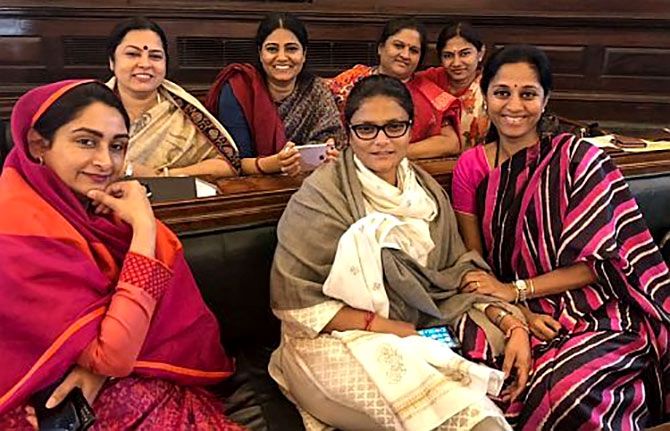 | « Back to article | Print this article |
'India will benefit hugely if the representation of women in Parliament is increased to a just level,' says Kumar Rajesh.

Modern societies increasingly demand gender equality, which is also a precondition for genuine democracy. Yet women are still under-represented in most parliaments in the world.
The Inter-Parliamentary Union in 2016 published a self-assessment toolkit for parliaments around the world to assess their gender sensitivity.
The toolkit consists of seven broad assessment guidelines among which the most significant one is to check whether there is a just representation and participation of women and men across all the bodies and internal structures of the parliament.
According to a 2017 United Nations and IPU report, India ranked 148th globally in terms of representation of women in Parliament.
Currently, in the 16th Lok Sabha, a mere 12.2 per cent of the MPs are women, and in the Rajya Sabha female MPs constitutes just 11.5 per cent of the total members.
Until the 14th Lok Sabha, the representation of women in the lower house of Parliament was less than 10 per cent.
The IPU assessment guideline also suggests checking the representation of men and women in parliamentary committees.
Department-related parliamentary committees play a crucial role in scrutinising the decisions, legislation and working of the government in India.
Therefore, participation of female MPs in these committees is of vital importance to ensure that the legislation and policies formulated by Parliament are gender-inclusive.
The IPU guideline poses questions such as: In which committees are women mostly represented? In which committees are women under-represented or absent?
While there is no written rule that makes it mandatory for an MP to be part of parliamentary standing committees, it is a norm followed by a majority of lawmakers.
An analysis of the committee membership data of 84 non-minister female MPs (60 from the Lok Sabha and 24 from the Rajya Sabha) shows that 13 per cent of female MPs are not members of any department-related standing committee.
In fact, the department-related standing committee on finance, which has a membership of 31 MPs, has no female member at all.
A major proportion of female MPs are members of standing committees on social justice and empowerment (9.5 per cent), followed by human resource development (8.3 per cent) and chemical and fertilisers (7.1 per cent).
Out of a total of 24 department-related standing committees in both houses of Parliament, not a single committee is headed by a female MP.
The concentration of female MPs in a particular group of committees reveals that the stereotypes of women's interests are reinforced by committee membership.
Along with representation, the participation of female MPs in parliamentary business is an important indicator of the gender-inclusiveness of parliament.
There are three major interventions through which an MP participates in parliamentary business -- by asking questions, participating in debates and motions, and introducing private member bills (PMBs).
According to data collected by PRS Legislative Research for the 16th Lok Sabha (June 1, 2014 to July 31, 2018), female MPs on average asked 234 questions in the Lok Sabha, compared to 236 questions by male MPs.
Similarly, female MPs on average participated in 56 debates while male MPs participated in 55 debates.
In the same time period, female and male MPs both introduced 1.6 PMBs on average in the Lok Sabha.
Thus one can conclude first, that female MPs are equally capable of fulfilling their parliamentary duties as their male counterparts; and second, that though India's Parliament is insensitive towards women in terms of representation, it provides an equal opportunity to female MPs to participate in the business of the house.
 IMAGE: BJP leader Sushma Swaraj, CPI-M leader Brinda Karat and Congress leader Prabha Thakur outside Parliament.
IMAGE: BJP leader Sushma Swaraj, CPI-M leader Brinda Karat and Congress leader Prabha Thakur outside Parliament.A recent study by the United Nations University found that women legislators in India raise economic performance in their constituencies by about 1.8 percentage points per year more than male legislators.
The report also noted that women legislators are more effective at completing road projects and hence creating infrastructure for growth. It also challenged the presumption that men are more effective at delivering growth-producing infrastructure.
It is evident that India will benefit hugely if the representation of women in Parliament is increased to a just level.
Given the patriarchal structure of Indian society, to mainstream Indian women in politics, affirmative action is needed.
The Constitution 108th Amendment Bill, commonly known as the Women's Reservation Bill, was a concrete step in this direction.
It sought to reserve one-third of all seats for women in the Lok Sabha and the state legislative assemblies. The Bill was passed by the Rajya Sabha on March 9, 2010, but the Lok Sabha didn't give its assent, and eventually it lapsed.
While it is very convenient to celebrate the symbolic value of electing the world's first woman prime minister or electing a woman as Speaker of the Lok Sabha, it is more crucial to address the gross under-representation of women in Parliament and within its different bodies and structures.
The current government should deliver on its manifesto promise of providing 33 per cent reservation for women in Parliament and in state assemblies.
Kumar Rajesh is a social policy researcher.